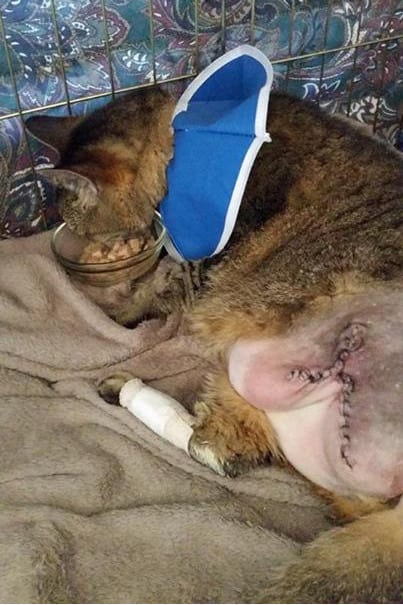Few things make us madder around here than a new Tripawd dog or cat amputee who gets sent home with nothing but a NSAID for pain control. That’s like taking nothing but an ibuprophen after getting your leg cut off! OUCH.
 September is Animal Pain Awareness Month. As pet parents it’s our responsibility make sure we are up on the latest veterinary pain management techniques.
September is Animal Pain Awareness Month. As pet parents it’s our responsibility make sure we are up on the latest veterinary pain management techniques.
Don’t assume your vet knows everything about pain control. Odds are, if your vet graduated from school back in the 1980s or earlier, they were not taught modern pain control procedures. In fact, common thinking back then was that pain is good for animals because it keeps them quiet. Isn’t that nuts?!

Great vets out there have taken the time to get current in veterinary pain control, but sadly, many have not. That’s why we’re so glad the IVAPM exists, to get the word out that we owe it to our animals to provide the pain relief they deserve no matter what their health or age.
Because Their Pain is Our Pain
Take a minute to learn a few things from the International Veterinary Association of Pain Management. Their website has information about Animals and Pain. For example, review the article: Common Signs of Pain in Dogs and Cats
Use the IVAPM Pet Pain Assessment charts below prepared courtesy of Colorado State University. Click the links below to view and download larger images.
How to Tell if Your Cat is in Pain
Take a look at the psychological and behavioral aspects of assessing your three-legged or four-legged cat:

How to Tell if Your Dog is in Pain
Check out the different ways that dogs show (and don’t show) when they’re hurting:

The IVAPM even shares this great article about animal amputees and pain control, which was originally published here in our News blog: Vet Expert Dr. Mike Petty Shares Tripawd Amputation Pain, Rehab Care Tips.
What to Do If Your Animal is in Pain
If you suspect or know your animal is in pain and you don’t like the answers you’re getting from your vet, please do not wait. Find a Certified Veterinary Pain Practitioner.
What’s a Certified Veterinary Pain Practitioner (CVPP)?
Certified Veterinary Pain Practitioners are veterinary professionals that IVAPM has recognized as having the training and skills necessary to practice animal pain management effectively and ethically. IVAPM’s certification program is rigorous and comprehensive, covering pain medications, physical rehabilitation and alternative therapies.
Certified Veterinary Pain Practitioners are committed to including pain management in the care of all of their patients. These include animals that are hurt, sick, or suffering from chronic conditions like arthritis. CVPPs assess every patient for pain, and work with clients to create treatment plans with comfort and safety in mind. They are trained to use a multi-modal approach to pain management, which could incorporate drugs, therapeutic laser, hydrotherapy, massage and acupuncture.
Use the IVAPM “Find a Member” Directory
Get your animal the pain control they deserve.
Recommended Reading
Best Pain Relief Tips for Tripawd Dogs and Cats
My girl Bella had her leg amputated at 6 months old. She just recently turned 4 and expierences “Ghost pains”. Is that normal?
What you are referring to as “ghost pain” could be pain associated with any number of things. Please consult your veterinarian, or better yet: consider seeking the professional opinion of a certified canine rehab vet/tech. They have specialized training to help identify the cause of orthopedic pain. Visit a CCRT or CCRP and the Tripawds Foundation will even pay for your first from the Maggie Moo Fund for Tripawd Rehab!
When my cat was diagnosed with arthritis several years ago, pain control was top of mind for his veterinarian, and we used a chart a lot like this to determine how bad his day-to-day life really was. Once I could see something like this, written out so clearly, it made caring for him so much easier. I no longer had to guess. Here’s hoping more people see this tool and have the same experience I did. It really does help.
-Jean
Thanks for sharing your experience Jean. Your animals are so lucky to have you for a mom and your vet sounds SO great, we wish more were as conscientious about pain management.
The chart is great for helping to identify pain.
It’s also great to know that there are certified specialists trained specifically for managing pain in animals.
Geez, to think animals were no given good pain meds back not too long ago. Awful!
I agree, I love those charts! I wish they were a bit bigger but they are very helpful, we’ll be pointing people here a lot.
Yep, I agree, it’s atrocious that we never gave animals pain meds in the past, even in our lifetimes. Yeeek!